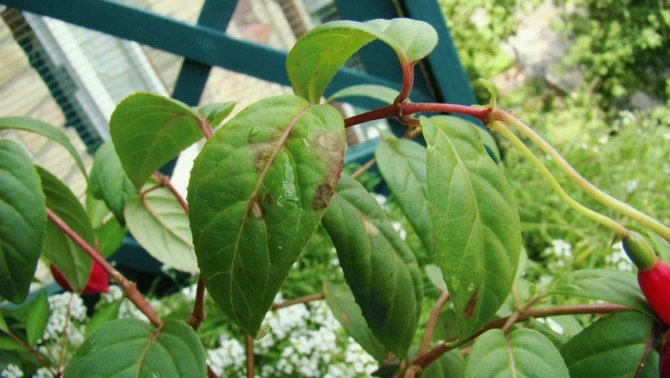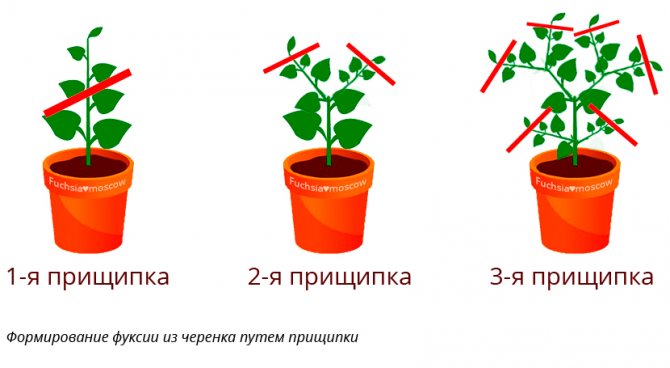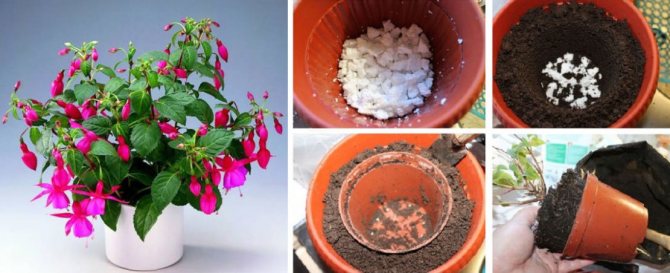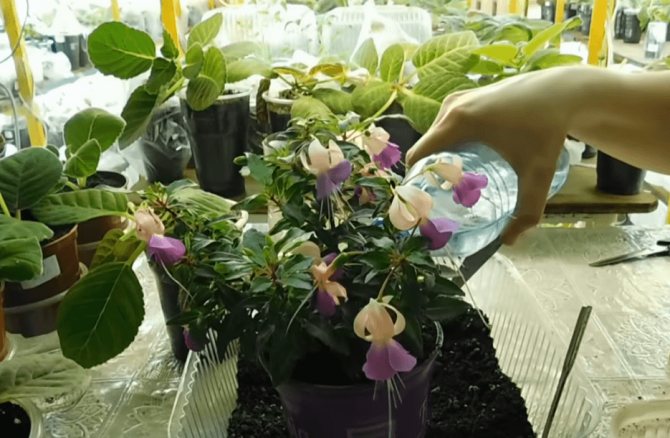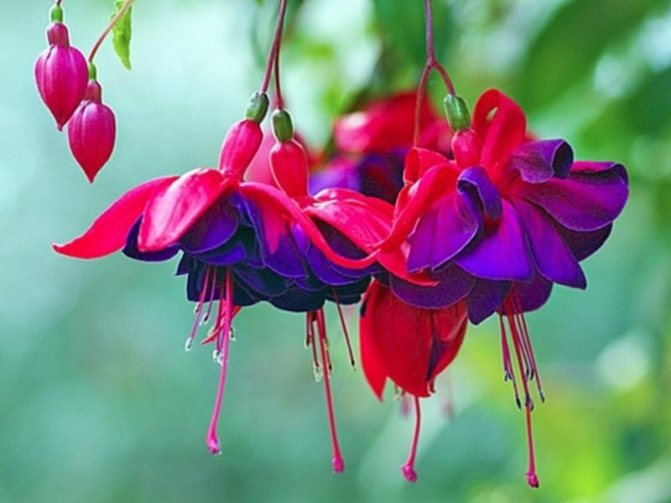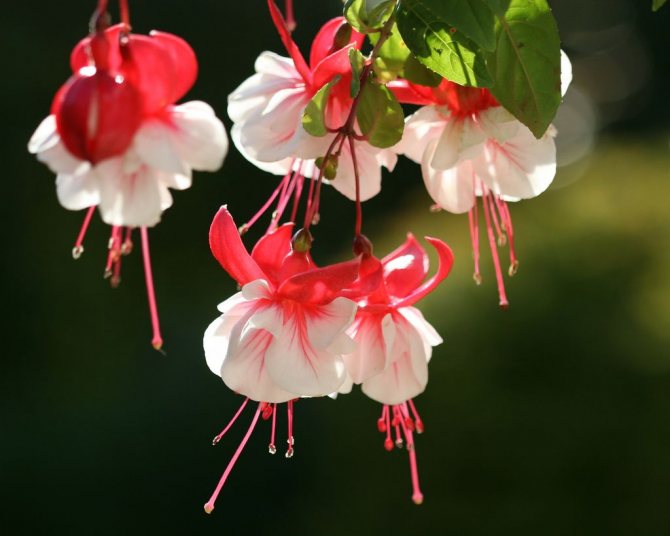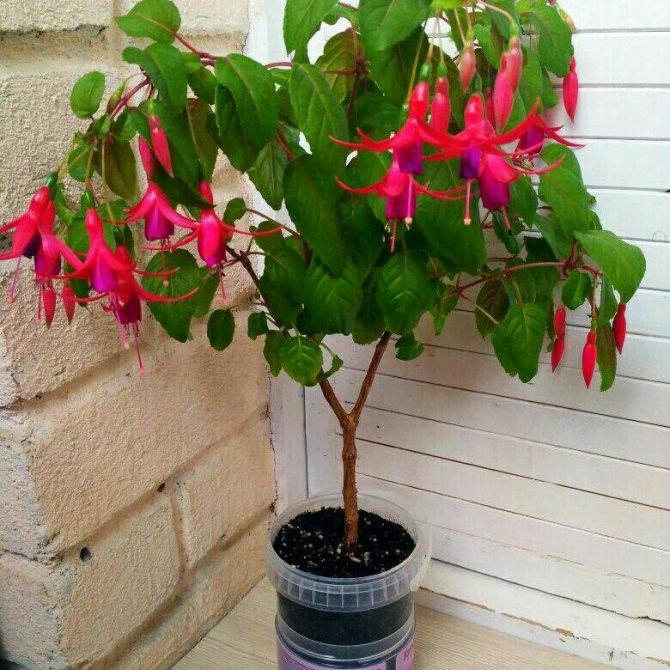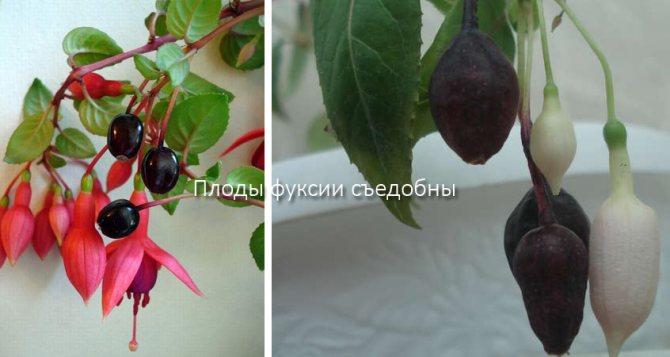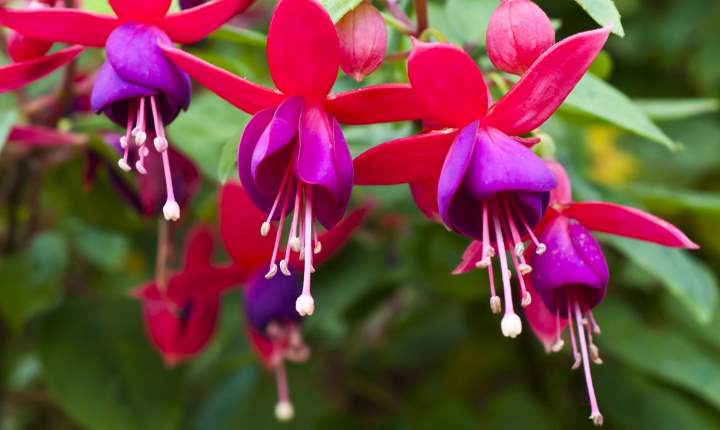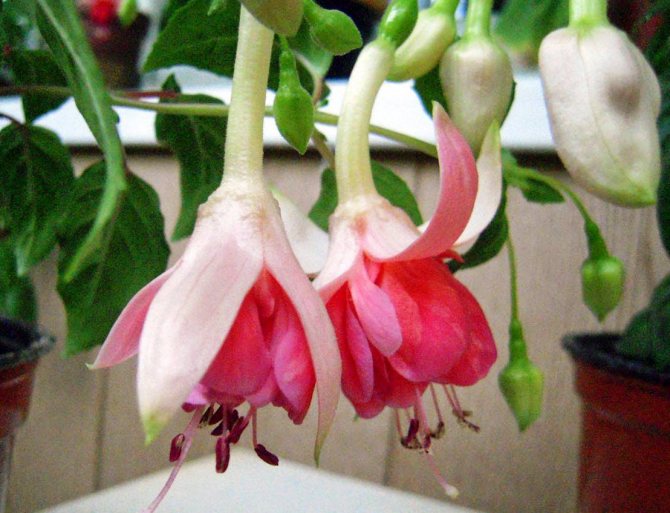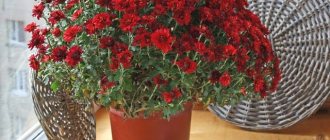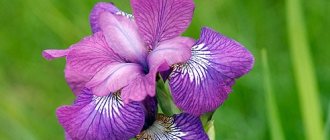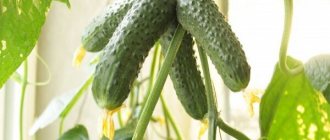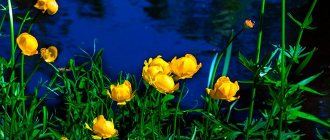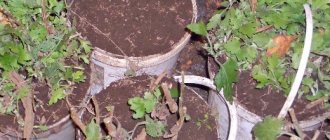At our summer cottage, my husband and I planted several fuchsia bushes, but not all the bushes were able to survive our harsh winter. I shared this problem with an experienced florist, he said that every autumn this plant must be dug out of open soil and stored in a cool room, and in the spring, after waking up, it must be planted again on the site. Since my husband and I began to follow this advice, not a single fuchsia has died in our country. In this article, I will tell you how to properly store fuchsia indoors in winter.
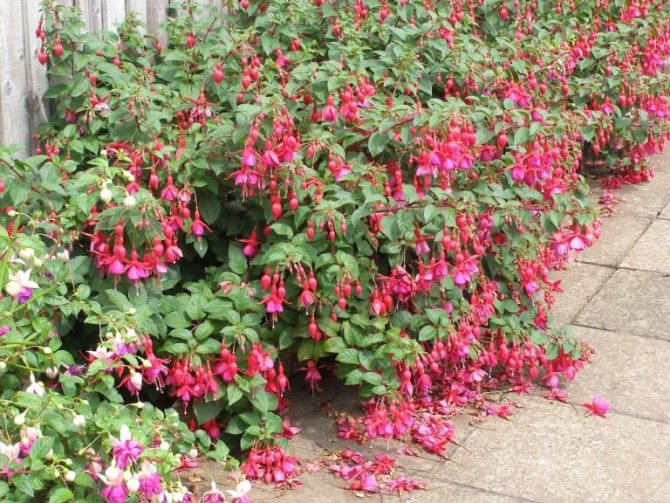
Care rules
Florists love fuchsia for its unpretentiousness and delicate flowering. It grows equally well both in open soil and in a pot; with proper care, it can easily live for about 60 years. It is very easy to care for her that even a beginner can handle:
- Watering - It belongs to moisture-loving shrubs, so it can be watered or sprayed. It is recommended to water it daily, but the portion of water should be small, otherwise the roots can rot from an excess of moisture. Before watering, touch the top layer of the earth, if it is dry at a depth of 1 centimeter, then watering is required. So that the roots do not suffer from an excess of water, a drainage layer must be installed at the bottom of the pit before planting, which will pick up excess moisture. If possible, set up automatic watering so that the shrub does not suffer from drought.
- Lighting - The shrub does not like direct sunlight, so it is better to place the container with it in partial shade. In open soil, the seedling is planted from the very beginning in the place where the sun looks only early in the morning or late in the evening. Before planting, be sure to consider what shade the flowers will be. If light, then partial shade is quite suitable, if dark, then the place should be lighter.
- Soil Composition - Can grow in almost any soil, as long as it contains less nitrogen. Black soil is best suited. From spring to autumn, the plant is regularly given a liquid feed with a low nitrogen content. In winter, she is not fed, since she is in a dormant period.
- Temperature - She does not tolerate hot weather. At an air temperature above + 26 ° C, its leaves become lethargic, it refuses to bloom. Therefore, in the summer it needs to be watered and sprayed more often, and also covered with paper from the scorching rays of the sun. If it grows in a pot, then it is temporarily transferred to a cool, but lighted place.
Subject to these simple rules, a beautiful shrub will bloom for many years.
Preparing for winter
But not all of its species will be able to survive the harsh Russian winter, so many flower growers transplant it into a container every autumn and place it in a cool room, and in the spring they wake it up and plant it again in open soil. If it grows in an apartment in a pot, then in the fall it needs to be prepared for a dormant period. If she cannot rest in winter, then in the new season she will refuse to bloom. Therefore, in order for the plant to successfully pass into the dormant period, these procedures are performed:
- Watering - From September, gradually reduce watering so that by frost the plant is already completely dry.
- Top dressing - From the end of August, fertilization is completely stopped. After that, the bush will shed all the greens and petals, preparing for winter.
- Lighting - The container with the plant is moved from the windowsill to a further room in the room, where the light is weaker. If the room is too dark, it is recommended to turn on an ordinary incandescent lamp for several hours a day. This will be enough.
- Air temperature - To help the houseplant enter the dormant period, the pot with it is transferred from a warm room to a cool balcony or basement, where the air temperature is kept no higher than + 14 ° C.
After the above, they wait until all the leaves fly off the plant, and the branches themselves become dry.
Winter care
After all the leaves and buds have fallen from her, she needs to provide normal conditions for hibernation. To do this, the bush is carefully dug out of the soil, the roots are shaken off the ground and carefully examined for parasites or rot. Rotten or parasitized roots are cut off with a clean tool.
The pot in which she will endure hibernation is thoroughly washed from the inside, disinfected. A sufficient drainage layer is poured at the bottom, then half covered with fresh soil with a low content of humus. After that, the bush is carefully planted in it and top up with soil.
After that, the plant is placed in a dark, humid place with a temperature not higher than + 14 ° C. You cannot put it in a warm place, otherwise it will not bloom in the new season. If suddenly in winter it began to germinate, then the sprouts need to be cut off, and the air temperature in the room should be lowered even more by airing.
If it is not possible to place this flower in the basement or on the balcony, then it is placed almost close to the window, which is often slightly opened for airing. So that the earth does not dry out at all, it is watered three or four times a month with warm water. To prevent parasites from growing on the bush during wintering, it must be treated with special means against insect pests.
Indoor fuchsia care rules:
- Daily ventilation of the room.
- The bottom needs to be insulated with foam so that the roots do not rot due to the cool air.
- Make sure that there is always humid air in the apartment.
- Watering no more than four times a month.
- Before wintering, treat the bush with an insect repellent.
- In the absence of sunlight, the bush should be illuminated during the day with ordinary incandescent lamps.
How to form fuchsia on a trunk: pruning scheme, recommendations
Fuchsia seeds - cultivation
What to do next when fuchsia has faded? After the fuchsia has faded, the faded cuttings and twigs that have formed above the young buds are removed.
The stem is formed from a healthy cutting with a strong, straight stem. When planting, a stick must be installed to support the main trunk. Next, you need to figure out how to form a planted fuchsia. To start forming fuchsia on a trunk, first it must be allowed to grow to the desired height, cutting off all lateral shoots. When the stem reaches the desired height, the top is cut off, immediately after that young lateral shoots begin to form. By pinching them, you can get a lush blooming bush.
The formation of a fuchsia crown is easy, this can give it a certain shape. For example, you can give it the shape of a heart, a ball, or a small tree, based on the expectation that two more will grow from each cut piece. They will be directed towards the corner at which the trim was made.


Fuchsia pruning scheme
Spring awakening
In March, when there are more and more sunny days, fuchsia begins to slowly emerge from hibernation:
- Pruning - In order for new shoots and leaves to grow on the bush, old branches are cut almost at the root. If they already have fresh shoots, then only the top is cut off.
- Place - Place the pot with the shank in a warm and well-lit place, but away from sunlight.
- Watering - Two or three times a week, as soon as the sun has set, the soil is watered with pre-separated water. During the month, the frequency of watering is gradually increased. So that the wood does not become covered with cracks, any container filled with water is placed next to it.
In a month, not only buds will appear on new branches, but also buds. It is transplanted into open soil only when the air temperature outside, even at night, will not be lower than + 10 ° C.
Fertilizers
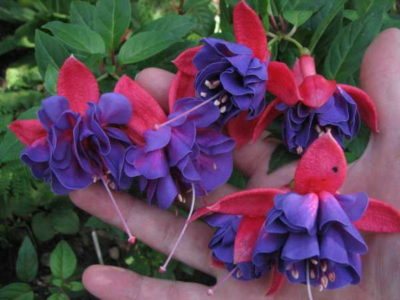

Top dressing begins immediately after wintering and spring pruning. You need to continue feeding until autumn. In specialty stores, you can buy fertilizers that are intended for flowering plants.
If you overfeed the fuchsia, then it will begin to grow foliage, but the flowering will be poor. To prevent this from happening, fertilizers are applied only once every couple of weeks. The composition of the preparations should include nitrogen, phosphorus, potassium and magnesium.
There are some the rules that must be followed when feeding a flower, after cutting it:
- Top dressing is done only in wet soil.
- Organic fertilizers need to be diluted with water twice as much as written in the instructions.
- During cold weather, the flower does not need feeding.
Reproduction
It is quite easy to reproduce it at home, which even a beginner can handle. As reproduction, one of three methods is usually chosen:
- Cuttings - At a bush that has emerged from hibernation, the shoot that has grown to 15 centimeters is cut off. It is placed in clean water or a moistened rooting substrate. Cover with a glass or bag to create a greenhouse environment. Air out daily. Then the rooted cutting is transplanted into the ground. The color of the petals will be exactly the same as that of the mother bush.
- Seeds - In this case, the seeds are simply planted in fertile soil, before the first shoots appear, the container with them is covered with a film, which is opened daily for airing. As it grows, the sprout is transplanted into a larger pot every fall or spring. At first, this procedure is done annually, as the roots require more and more space. The disadvantage of the seed propagation method is that the color of the petals may not be the same as that of the mother shrub.
- Leaf - The largest leaf with a petiole is cut from a branch, placed in a nutrient substrate and covered with a glass or film, remembering to air daily. After a month, the rooted shoot is transplanted into a larger pot.
What kind of land does fuchsia love?
The quality of development of any plant depends on the soil. It provides nutrition, moisture, and promotes proper aeration of the roots.
Fuchsia favors light, fertile soil. Good drainage is essential. Neutral acidity is desirable, but slightly acidic will work as well.
As a basis, you can use purchased primer, for example, universal. For this culture, it will have to be diluted with sand. But it is best to prepare the soil mixture yourself.
What soil is needed for fuchsia
There are several options for self-mixing.
For the first, you can mix an equal amount of peat, decayed foliage, compost and add a double volume of sand.
A composition of loamy soil, peat and sand will be good. The recommended proportions are 7: 3: 2.
In the presence of loamy or sandy loam sod, you can make a mixture based on them. How does the supplement go:
- granular peat (or leaf humus);
- wood ash.
If the turf from pastures, that is, very nutritious, can be mixed with a small amount of peat and sand (6: 2: 1). With a slight correction, it can also be used for planting cuttings (4: 2: 1).
Important! It is not recommended to use fine sand from the quarry. Only river is suitable - large, washed.
In recent years, coconut soil has come into vogue.It is made from the hairy skin of the nuts. The material is extremely moisture-consuming, rich in trace elements, and decomposes for a very long time.
For fuchsia, adding it to the ground is simply salvation. It is almost impossible to pour in the coconut mixture, which means that the roots of the plant are safe.
Sometimes sphagnum moss is used to increase the air permeability of the soil.
Also, a small amount is added to the mixture:
- complex fertilizers (for flowering plants);
- vermiculite;
- needles needles;
- hydrogel.
Note! When planting, be sure to fill in a high layer of drainage. Broken bricks, stones, etc. can be used.
The finished mixture must be sterilized before planting. Disinfection can be achieved by calcining, deep freezing. True, then you will have to populate the soil with beneficial bacteria. Biological products (for example, phytodoctor) will help with this.
Diseases
If a once healthy flower suddenly became lethargic or the color and shape of the leaves changed, then this indicates that it has picked up a fungal disease or parasites. In this case, it must be carefully examined in order to understand exactly how to treat:
- Rust - It occurs during wintering due to excessive humidity in a cool room and frequent watering, as well as lack of fresh air. In this case, the infected plant most often dies, so that this does not happen, before wintering it must be treated with a 1% solution of Bordeaux mixture, which will protect fuchsia from the fungus. If the infection is insignificant, then the bush can still be saved. To do this, dissolve 50 grams of grated green soap and 3 grams of copper sulphate in a liter container with water, then they are treated with infected greens.
- Powdery mildew - Appears as white spots on branches or leaves due to increased moisture in the soil. You can get rid of it with the help of "Fundazol".
- Chlorosis - Greens turn yellow and fall off, this is due to excessive watering in a cold room. To save the bush, it is watered with well-diluted potassium permanganate.
- White fly larvae - They are found on the underside of the leaves, from where they drink all the nutrients, after which all the greens die off. To get rid of these larvae, everyone is treated with Aktellik.
- Sluggish Leaves - Lack of sunlight and nutrients. It is necessary to rearrange the pot to another lighter place and give a complex feeding.
Formation of fuchsia at home
The plant has very unusual flowers. Fancy-shaped buds combine several shades. It is not for nothing that the flower is popularly known as a ballerina, gypsy earrings, and the flower of elves.
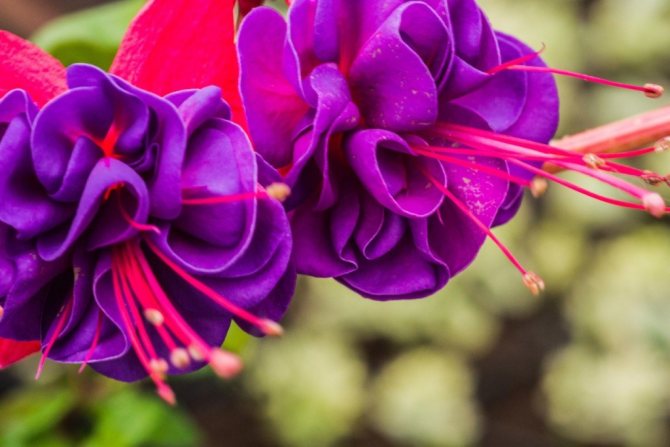

Fuchsia grows very strongly and rapidly
The flower adapts well to the conditions of detention, grows quickly, so it has to be cut regularly, that is, given the desired shape. What it will be depends on the wishes of the owner.
First of all, pruning is needed to remove shoots:
- damaged;
- too long, thin, naked;
- lignified.
Important! Under no circumstances should the main barrel be touched.
Faded branches should be removed regularly to the young buds under them.
How fuchsia grows
In nature, there are shrubby and tree-like varieties of ballerina. Both have elastic flexible stems. An adult plant in natural conditions reaches a height of 1 m. The leaves are not very large. The shape of the leaf is an oval pointed at the end. The colors are green and green-reddish. The edge of the plate is slightly serrated.


Garden fuchsia
Note! Flowering is very long. In shape, the buds consist of a corolla cup and a tubular corolla. The stamens look very interesting, they are long and resemble drops.

